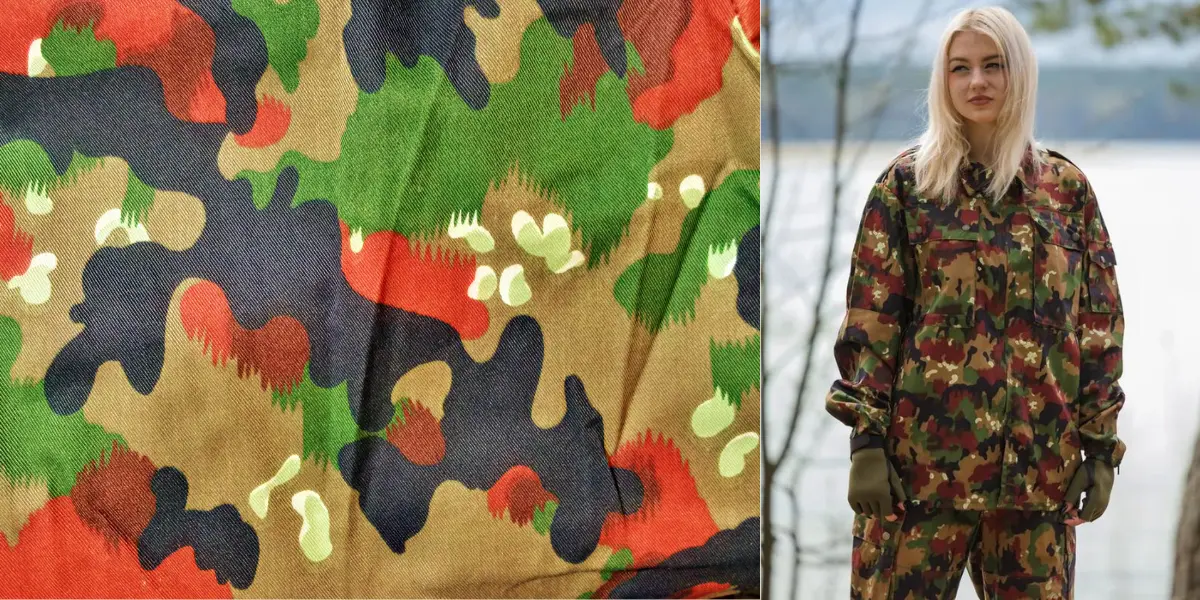The alpenflage camouflage pattern, a unique and distinctive design, has become an iconic symbol of Swiss military heritage. From its inception in the mid-20th century to its widespread use and subsequent replacement, alpenflage has left a lasting legacy in military history. In this comprehensive article, we delve into the history, design, and cultural significance of alpenflage, offering a detailed exploration of its origins and evolution.
Origins of Alpenflage: A Swiss Innovation
Alpenflage, also known as TASS 57 or M57, was developed in the 1950s during a period of modernization within the Swiss Armed Forces. The design was specifically created to provide effective camouflage in the diverse and rugged terrains of Switzerland, including alpine forests, grasslands, and rocky landscapes. The pattern’s development was influenced by the need for a uniform that could blend seamlessly into these environments, offering soldiers enhanced concealment.
The Swiss military sought a solution that combined practicality with advanced materials. The result was a camouflage pattern that featured a distinctive combination of green, brown, tan, and red hues, interspersed with black and white specks. This unique mix of colors and patterns was designed to mimic the natural elements found in Switzerland’s varied landscapes, making it an ideal choice for the country’s defense forces.
The Design and Features of Alpenflage
The alpenflage pattern is characterized by its complex and multi-layered design. Unlike other camouflage patterns that typically use a limited color palette, alpenflage incorporates a wide range of colors to achieve its distinctive appearance. The use of red and white elements was particularly unusual, as these colors are generally not associated with camouflage. However, their inclusion was intended to break up the human silhouette and create a disruptive effect, making it more difficult for the enemy to detect soldiers at a distance.
One of the standout features of alpenflage is its utility and functionality. The uniform was designed with practicality in mind, featuring multiple pockets, reinforced areas, and adjustable components. The material used was durable and suited for the harsh alpine climate, protecting cold and wet conditions. The uniform’s versatility made it suitable for various roles within the military, from infantry to specialized units.
The Widespread Use and Popularity of Alpenflage
Alpenflage became the standard issue camouflage for the Swiss Armed Forces in the late 1950s and remained in use for several decades. Its widespread adoption was due in part to its effectiveness in the diverse Swiss terrain, as well as its distinctive appearance, which quickly became a symbol of Swiss military identity.
Beyond its practical applications, alpenflage gained popularity among collectors and enthusiasts. The pattern’s unique aesthetic made it a sought-after item in the surplus market, and it was often seen in civilian use as well. Alpenflage became a cultural icon, representing a blend of Swiss ingenuity and military tradition. Its presence extended beyond Switzerland’s borders, as other nations and military organizations took note of its innovative design.
The Decline and Replacement of Alpenflage
Despite its initial success and popularity, alpenflage eventually faced challenges that led to its decline. Advances in camouflage technology and the development of more modern patterns rendered alpenflage less effective in contemporary military operations. The bright red and white elements, while effective in the Swiss environment, were less suitable for international deployments and missions in different terrains.
In the 1990s, the Swiss Armed Forces began transitioning to a new camouflage pattern, known as M90. This updated design featured a more subdued color palette, better suited for modern combat environments. The M90 pattern replaced alpenflage as the standard issue, marking the end of an era for the iconic camouflage. Despite this, alpenflage remains a beloved and nostalgic symbol of Swiss military history.
Alpenflage in Popular Culture and Modern Usage
Even after its official retirement from the Swiss Armed Forces, alpenflage continues to have a presence in popular culture and modern fashion. The pattern’s distinctive design has been embraced by fashion designers, streetwear brands, and outdoor enthusiasts. Its bold colors and unique aesthetic have made it a favorite among those looking to make a statement with their clothing choices.
In addition to fashion, alpenflage has also appeared in various media, including movies, video games, and art. Its iconic status has made it a recognizable and influential pattern, often used to evoke a sense of nostalgia or to pay homage to military history. The enduring appeal of alpenflage is a testament to its impact and significance in both military and civilian contexts.
The Legacy of Alpenflage: A Lasting Impact
Alpenflage’s legacy extends beyond its practical use as a military uniform. It represents a unique chapter in the history of camouflage and military innovation. The pattern’s distinctive design and its role in the Swiss Armed Forces have left a lasting impression on both military enthusiasts and the general public.
As we reflect on the history and evolution of alpenflage, it is clear that this iconic camouflage pattern holds a special place in the annals of military history. Its influence can be seen in the design of other camouflage patterns and its continued presence in popular culture. While it may no longer be in active use, alpenflage remains a symbol of Swiss ingenuity and military tradition.
Conclusion
Alpenflage, with its distinctive and innovative design, has left an indelible mark on the history of military camouflage. From its origins in the 1950s to its widespread use and eventual replacement, it has been a symbol of Swiss military identity and ingenuity. Its unique combination of colors and patterns provided effective concealment in Switzerland’s diverse landscapes and became a cultural icon both within and beyond the country’s borders.
Read our more Blogs…



